
|
You entered: filament
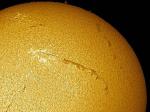 Filaments Across the Sun
Filaments Across the Sun
5.12.2004
Two unusually long filaments crossed part of the Sun last week. The filaments are actually relatively cool and dark prominences of solar plasma held up by the Sun's magnetic field but seen against the face of the Sun. Filaments typically last a few weeks before falling back.
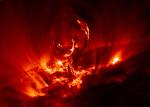 A Solar Filament Lifts Off
A Solar Filament Lifts Off
9.08.2000
Hot gas frequently erupts from the Sun. One such eruption produced the glowing filament pictured above, which was captured on July 19 by the Earth-orbiting TRACE satellite. The filament, although small compared...
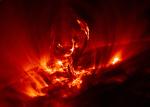 A Solar Filament Lifts Off
A Solar Filament Lifts Off
25.07.2004
Hot gas frequently erupts from the Sun. One such eruption produced the glowing filament pictured above, which was captured in 2000 July by the Earth-orbiting TRACE satellite. The filament, although small compared...
 A Huge Solar Filament Erupts
A Huge Solar Filament Erupts
30.07.2016
Filaments sometimes explode off the Sun. Featured, a huge filament had been seen hovering over the Sun's surface for over a week before it erupted late in 2010. The image sequence was taken by the Earth-orbiting Solar Dynamics Observatory (SDO) in one color of ultraviolet light.
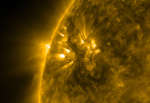 Dark Filament of the Sun
Dark Filament of the Sun
22.05.2010
Suspended by magnetic fields above a solar active region this dark filament stretches over 40 earth-diameters. The ominous structure appears to be frozen in time near the Sun's edge, but solar filaments are unstable and often erupt.
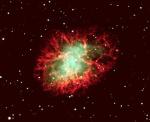 M1: Filaments of the Crab Nebula
M1: Filaments of the Crab Nebula
7.02.1998
The Crab Nebula, filled with mysterious filaments, is the result of a star that exploded in 1054 AD. This spectacular supernova explosion was recorded by Chinese and (quite probably) Anasazi Indian astronomers. The filaments...
 M1: Filaments of the Crab Nebula
M1: Filaments of the Crab Nebula
6.02.1997
The Crab Nebula is filled with mysterious filaments. The Crab Nebula is the result of a star that exploded in 1054 AD. This spectacular supernova explosion was recorded by Chinese and (quite probably) Anasazi Indian astronomers.
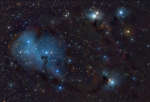 A Filament in Monoceros
A Filament in Monoceros
17.03.2022
Bluish reflection nebulae seem to fill this dusty expanse. The sharp telescopic frame spans over 1 degree on the sky toward the faint but fanciful constellation Monoceros, the Unicorn. Seen within the Monoceros...
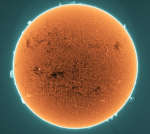 Prominences and Filaments on the Active Sun
Prominences and Filaments on the Active Sun
14.06.2024
This colorized and sharpened image of the Sun is composed of frames recording emission from hydrogen atoms in the solar chromosphere on May 15. Approaching the maximum of solar cycle 25, a multitude of active regions and twisting, snake-like solar filaments are seen to sprawl across the surface of the active Sun.
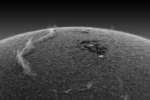 A Filament Across the Sun
A Filament Across the Sun
20.08.2012
Is that a cloud hovering over the Sun? Yes, but it is quite different than a cloud hovering over the Earth. The long light feature on the left of the above color-inverted image is actually a solar filament and is composed of mostly charged hydrogen gas held aloft by the Sun's looping magnetic field.
|
January February March |
||||||||||||||||||||||||||||||||||||||||||||||||||||||||